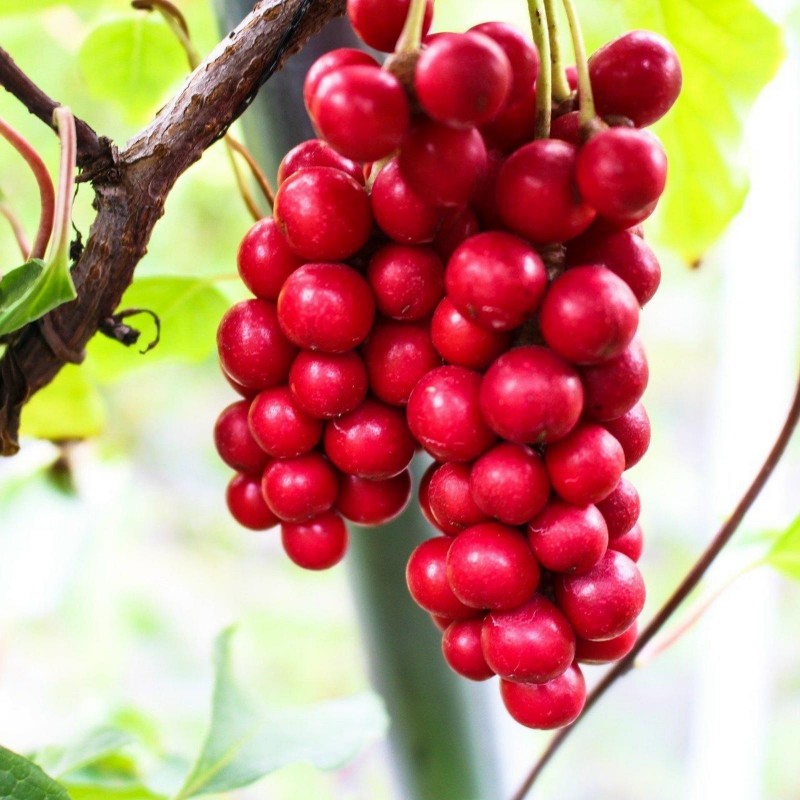
Planta rezistenta la frig si inghet







MAGNOLIA BERRY – FIVE FLAVOR BERRY Seeds (Schisandra chinensis)
Price for Package of 5 seeds.
Schisandra chinensis (五味子 in Chinese, pinyin: wǔ wèi zi, literally "five-flavor berry" which is its common name is a deciduous woody vine native to forests of Northern China and the Russian Far East. It is hardy in USDA
Schisandra chinensis (五味子 in Chinese, pinyin: wǔ wèi zi, literally "five-flavor berry" which is its common name is a deciduous woody vine native to forests of Northern China and the Russian Far East. It is hardy in USDA Zone 4. The plant likes some shade with moist, well-drained soil. The species itself is dioecious, thus flowers on a female plant will only produce fruit when fertilized with pollen from a male plant. However, a hybrid selection titled 'Eastern Prince' has perfect flowers and is self-fertile. Seedlings of 'Eastern Prince' are sometimes sold under the same name, but are typically single-sex plants.
Schisandra is native to northern and northeastern China (Manchuria). Cultivation requirements are thought to be similar to those of grapes. Plants require conditions of moderate humidity and light, together with a wet, humus-rich soil. Tens of tons of berries are used annually in Russia in Primorsky Krai and Khabarovsk Krai for the commercial manufacture of juices, wines, extracts, and sweets.
Its Chinese name comes from the fact that its berries possess all five basic flavors: salty, sweet, sour, pungent (spicy), and bitter. Sometimes, it is more specifically called běi wǔ wèi zi (Chinese: 北五味子); literally "northern five-flavor berry") to distinguish it from another traditionally medicinal schisandraceous plant Kadsura japonica that grows only in subtropical areas. Another species of schisandra berry, Schisandra sphenanthera, has a similar but different biochemical profile; the Chinese pharmacopia distinguishes between S. chinensis (běi wǔ wèi zi) and S. sphenanthera (nan wǔ wèi zi).
Its berries are used in traditional Chinese medicine, where it is considered one of the 50 fundamental herbs. Chemical constituents include the lignans schisandrin, deoxyschisandrin, gomisins, and pregomisin, which are found in the seeds of the fruit. It should not be used by pregnant women.
In China, a wine is made from the berries.
In Korean, the berries are known as omija (hangul: 오미자 – five flavours). The cordial drink made from the berries is called omija cha (hangul: 오미자 차), meaning "omija tea"; see Korean tea.
In Japanese, they are called gomishi (Japanese: ゴミシ). The Ainu people used this plant, called repnihat, as a remedy for colds and sea-sickness.
In traditional Chinese medicine, S. chinensis (known as wu wei zi (Chinese: 五味子)) is believed to act as an astringent for the Qi of the lungs and kidneys, restrain the essence to treat diarrhea, arrest excessive sweating from deficiency of yin or yang, calm the spirit by refreshing the heart and kidneys, and generate body fluid and reduce thirst.
The great interest in limonnik (S. chinensis) in Russia arises from results of ethnopharmacological investigations of Russian scientists in the Far East regions where the berries and seeds were used by Nanai (Goldes or Samagir) hunters to improve night vision, as a tonic and to reduce hunger, thirst and exhaustion since “it gives forces to follow a sable all the day without food”."Pharmacological studies on animals have shown that Schisandra increases physical working capacity and affords a stress-protective effect against a broad spectrum of harmful factors including heat shock, skin burn, cooling, frostbite, immobilisation, swimming under load in an atmosphere with decreased air pressure, aseptic inflammation, irradiation, and heavy metal intoxication. The phytoadaptogen exerts an effect on the central nervous, sympathetic, endocrine, immune, respiratory, cardiovascular, gastrointestinal systems, on the development of experimental atherosclerosis, on blood sugar and acid-base balance, and on uterus myotonic activity."
Seed - best sown in the autumn in a cold frame. Pre-soak stored seed for 12 hours in warm water and sow in a greenhouse in the spring. Germination can be slow and erratic. Prick out the seedlings into individual pots when they are large enough to handle and grow them on in light shade in the greenhouse for their first 2 years. Plant them out into their permanent positions in early summer.
Fisa tehnica

 Reviews (0)
Reviews (0)